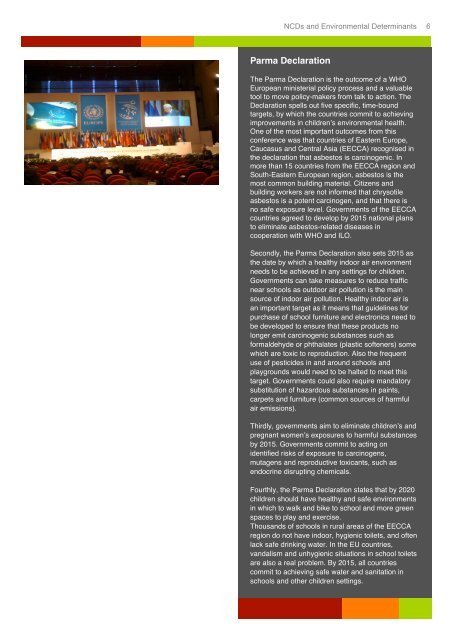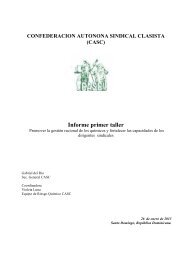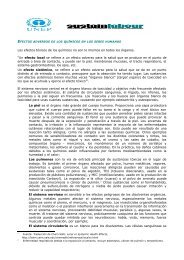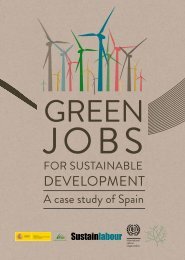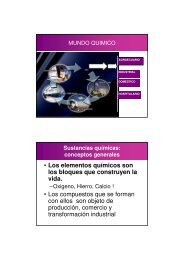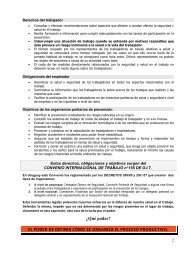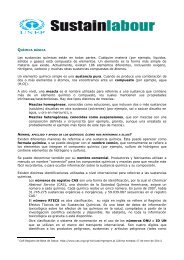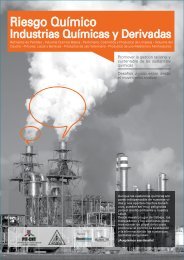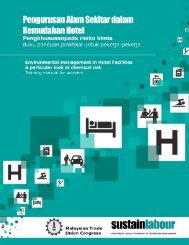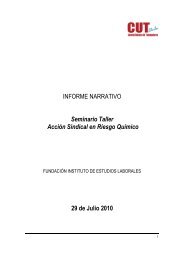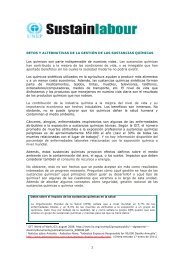Non-Communicable Diseases and Environmental Determinants
Non-Communicable Diseases and Environmental Determinants
Non-Communicable Diseases and Environmental Determinants
You also want an ePaper? Increase the reach of your titles
YUMPU automatically turns print PDFs into web optimized ePapers that Google loves.
NCDs <strong>and</strong> <strong>Environmental</strong> <strong>Determinants</strong> 6<br />
Parma Declaration<br />
The Parma Declaration is the outcome of a WHO<br />
European ministerial policy process <strong>and</strong> a valuable<br />
tool to move policy-makers from talk to action. The<br />
Declaration spells out five specific, time-bound<br />
targets, by which the countries commit to achieving<br />
improvements in children’s environmental health.<br />
One of the most important outcomes from this<br />
conference was that countries of Eastern Europe,<br />
Caucasus <strong>and</strong> Central Asia (EECCA) recognised in<br />
the declaration that asbestos is carcinogenic. In<br />
more than 15 countries from the EECCA region <strong>and</strong><br />
South-Eastern European region, asbestos is the<br />
most common building material. Citizens <strong>and</strong><br />
building workers are not informed that chrysotile<br />
asbestos is a potent carcinogen, <strong>and</strong> that there is<br />
no safe exposure level. Governments of the EECCA<br />
countries agreed to develop by 2015 national plans<br />
to eliminate asbestos-related diseases in<br />
cooperation with WHO <strong>and</strong> ILO.<br />
Secondly, the Parma Declaration also sets 2015 as<br />
the date by which a healthy indoor air environment<br />
needs to be achieved in any settings for children.<br />
Governments can take measures to reduce traffic<br />
near schools as outdoor air pollution is the main<br />
source of indoor air pollution. Healthy indoor air is<br />
an important target as it means that guidelines for<br />
purchase of school furniture <strong>and</strong> electronics need to<br />
be developed to ensure that these products no<br />
longer emit carcinogenic substances such as<br />
formaldehyde or phthalates (plastic softeners) some<br />
which are toxic to reproduction. Also the frequent<br />
use of pesticides in <strong>and</strong> around schools <strong>and</strong><br />
playgrounds would need to be halted to meet this<br />
target. Governments could also require m<strong>and</strong>atory<br />
substitution of hazardous substances in paints,<br />
carpets <strong>and</strong> furniture (common sources of harmful<br />
air emissions).<br />
Thirdly, governments aim to eliminate children’s <strong>and</strong><br />
pregnant women’s exposures to harmful substances<br />
by 2015. Governments commit to acting on<br />
identified risks of exposure to carcinogens,<br />
mutagens <strong>and</strong> reproductive toxicants, such as<br />
endocrine disrupting chemicals.<br />
Fourthly, the Parma Declaration states that by 2020<br />
children should have healthy <strong>and</strong> safe environments<br />
in which to walk <strong>and</strong> bike to school <strong>and</strong> more green<br />
spaces to play <strong>and</strong> exercise.<br />
Thous<strong>and</strong>s of schools in rural areas of the EECCA<br />
region do not have indoor, hygienic toilets, <strong>and</strong> often<br />
lack safe drinking water. In the EU countries,<br />
v<strong>and</strong>alism <strong>and</strong> unhygienic situations in school toilets<br />
are also a real problem. By 2015, all countries<br />
commit to achieving safe water <strong>and</strong> sanitation in<br />
schools <strong>and</strong> other children settings.


